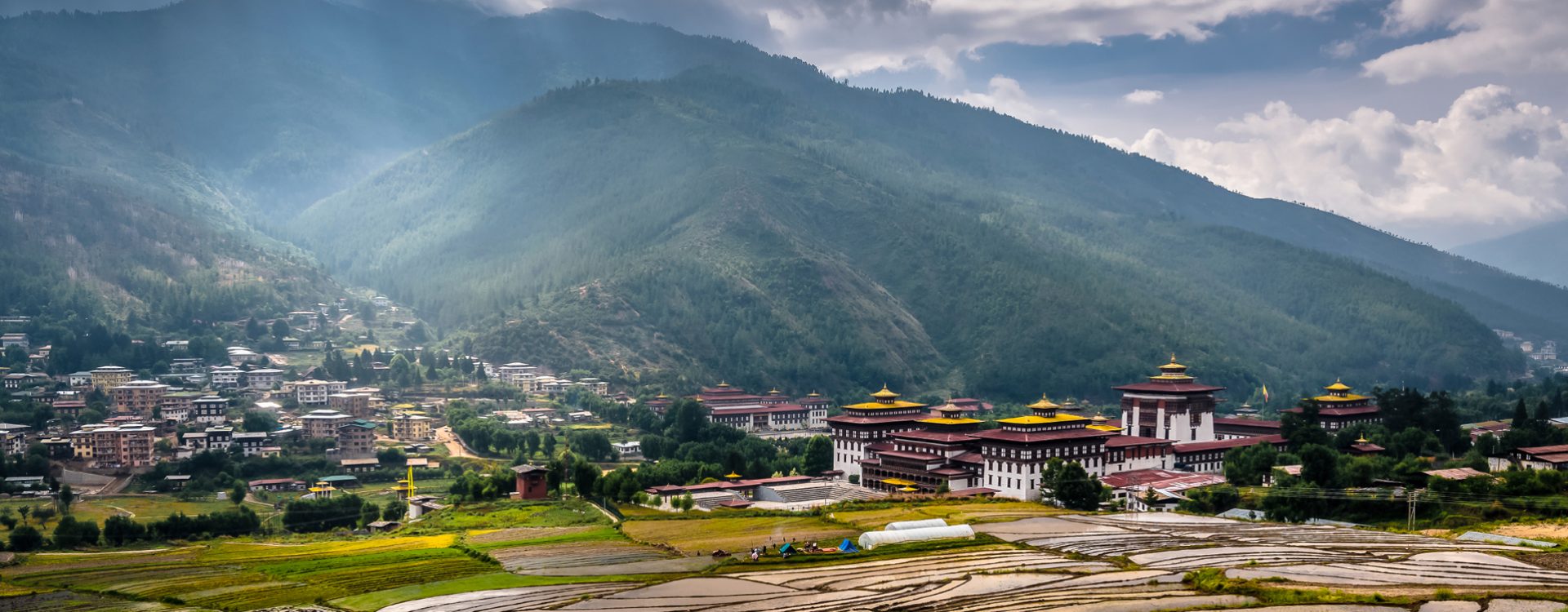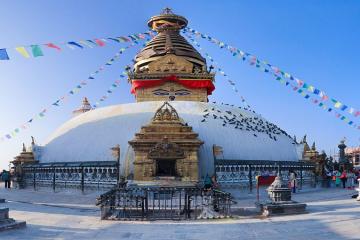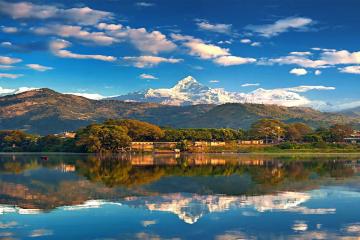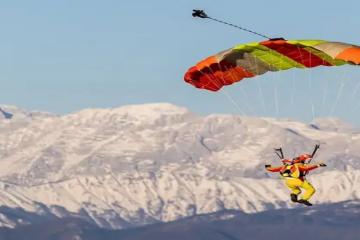

Participate in the well-known Glimpse of Bhutan Tour offered by Accessible Adventure. During this cultural tour to Bhutan, you will see some of the most important cultural centers in the Land of the Thunder Dragon, such as Paro, Thimpu, and Punakha.Those who are looking for a quick and enjoyable trip to the mysterious nation of Bhutan should sign up for this tour that lasts for five days.
The only international airport in Bhutan is located in the Paro valley, which also contains the city of Paro. The Paro valley is considered to be a holy location in Bhutan. The Dungtse Lhakhang temple in Paro dates back to the 15th century when it was first constructed. The Paro Taktsang Monastery, often known as the Tiger's Nest Monastery across the globe, can be found about 10 kilometers away from the town of Paro. It is widely regarded as Bhutan's greatest architectural achievement. Guru Padmasambhava is said to have flown all the way from Tibet to Bhutan and settled there, according to local mythology. Additionally located in Paro is the Ta-Dzhong, which was finished in 1649 and is the tallest structure in all of Bhutan.
Thimpu, the nation's capital and largest city, is widely regarded as the ideal location from which to gain exposure to Bhutan's rich cultural heritage. Traditional Bhutanese architecture was used in the construction of the Thimpu Tasichho Dzong, which is both a fortress and a Buddhist monastery. The fact that the Dzong is located next to the Wangchhu river makes for a stunning combination of cultural significance and scenic splendor. In addition, the city of Thimpu is the location of one of the most respected memorials, which is devoted to Jigme Dorji Wangchuk, the third King of Bhutan. At addition, there is a Buddha statue in Thimpu that is 52 meters (169 feet) tall. The statue is perched on the summit of a hill, providing visitors with breathtaking vistas of the mountains in the region as well as the valley that contains Thimpu.
Up until 1955, the capital of Bhutan was once located in Punakha. It is the location of the 108 Druk Wangyal Chortens, which serve as memorials to the Bhutanese soldiers who lost their lives in a battle against Assamese insurgents in 2003. The Temple of Khamsum Yuley in Punakha is the most ornately constructed of all of the temples. There are many frescoes, paintings, and idols inside of this palace, which was constructed by the Queen Mother of Bhutan's fifth King. Punakha Dzong - The religious and administrative center of the region, the Dzong was constructed in 1637 by Zhabdrung Ngawang Namgyal to take advantage of its advantageous location at the confluence of the Pho Chu and Mo Chu rivers. Its current purpose remains unchanged. This particular Dzong is quite well-known throughout all of Bhutan. Travel back in time and across history by visiting the Kyichu temple, which was built in the seventh century. You will find yourself at ease in this place, since the name of the temple alludes to the fact that it is a wellspring of serenity. Within walking distance of the temple is a home that has been transformed into a museum in memory of the late Dilgo Khyentse Rinpoche. There are photographs and other objects that were once owned by Rinpoche that are still around.
Overall, this glimpse of Bhutan tour will take you to the heart of the country, where you will get to encounter stunning natural and cultural treasures that are unrivaled anywhere else in the world. It will also take you to some of the most famous and esoteric architecture in the world.
Bhutan is a great place to visit any time of year, and each time of year has something different to offer. The best time to go to Bhutan is in the spring, from March to May, when flowers bloom in the valleys. Whether it's because of its festivals or celebrations, its clear skies and views of the Himalayan peaks, its thriving plants and animals, or its beautiful snowfall. But be aware that this is a busy time for travelers, so it might be hard to get a travel permit or a room. Bhutan will make sure you have a great time in nature and all of its beautiful offspring, and you'll take home a memory you'll remember for the rest of your life. Because it rains a lot from June to August, this is the "low season," when trekking is less likely to happen. The Glimpse of Bhutan tour can be undertaken at all times throughout the year. The best and therefore the tourist high-season lies from March-May and September to November. During these times the weather and climate is perfect to explore. Monsoon seasons and Summer (June-July) will bring with it rains and hence will make for a messier trip.
Accessible Adventure is a travel and tour organization run and managed by a team of experienced, veteran Nepalese nationals. This personnel has vast experience organizing and managing vacation locations in Bhutan, Nepal, and Tibet across the Himalayas.
We are a leading and ascending travel company situated in Kathmandu, Nepal, with over a decade of expertise executing successful tours with one-of-a-kind quality services at reasonable pricing. During your stay with us, you will be able to enjoy all of the Himalayan vacation locations that we provide.
Every one of our vacations is meticulously planned and coordinated, and we receive constantly positive feedback from both past and present customers and clients. They express great satisfaction and appreciation for the value of the vacations we provide.
When you get to Kathmandu, we will be there to meet you at the airport to greet you. While you are in our care, we will make sure that all of your travel needs are met in a timely manner. Since there are no plans for activities for the day, we will assist you in checking into the appropriate accommodation since there are none scheduled. You have the option of either going for a walk around the neighborhood or unwinding in each of your own rooms.
Swayambhunath, popularly known as the monkey Temple, Pashupatinath, one of Nepal's biggest temples, and Bouddhanath, a sizable stupa, are all on the itinerary for today.
Pashupatinath Temple is consecrated to Lord Shiva, popularly known as the "Lord of All Beings," and is one of the earliest Hindu temples. Lord Shiva is a symbol of the universe's destructive side. The Pashupatinath complex is traversed by the famous Bagmati River. On the banks of the river, the majority of Hindus in the Kathmandu Valley perform cremation rites for the deceased.
Swayambhunath Stupa: The Swayambhunath stupa is one of Nepal's most treasured Buddhist monuments. It is thought to have been created when the Bodhisattva Manjushri used his flaming sword to carve a canyon at Chhobhar to drain the waters of the huge lake that served as Kathmandu in ancient times.
Bouddhanath: Lord Buddha's four pairs of eyes are placed in the four cardinal directions atop the 2500-year-old Buddhist stupa in the Valley that was built in the fifth century. This stupa is known as Bouddhanath. This stupa continuously observes people and their behavior. As they round the stupa, Tibetan Buddhist pilgrims may be seen spinning prayer wheels.
Using this day, we also prepare for our flight to Paro and successive Glimpse of Bhutan Tour.
Today we take an early flight to Paro from Kathmandu Airport. We will take you 2 hours before your scheduled flight via private vehicle giving you ample time to clear the airport formalities. The flight from Kathmandu to Paro lasts around one and half hours. As you are collected at Paro airport, we will be taking you via private vehicle to the capital city of Bhutan, Thimpu.
Today we will visit the National Memorial Chorten and the Thimpu Tashichho Dzong. In 1974, the National Memorial Chorten was constructed as a monument in memory of Jigme Dorji Wangchuk, who served as Bhutan's third king (1928-1972). The Thimphu Tashichho Dzong is a fortress and Buddhist monastery located in Thimphu that features an architectural style that is uniquely Bhutanese. The current seat of the Druk Desi, the head of the civil administration, and the offices of the current monarch are located in this building, which is located on the banks of the Wang Chhu river.
After our tour, we will take you back to your hotel for the evening or you can stroll around the streets of Thimpu as well.
Today after you wake up and we take breakfast, we will take a scenic drive to the Buddha point in Kuenselphodrang National park. It houses one of the largest sitting Buddha staties in the world. It is perched on a hill where you can get panoramic views of the valley and the mountains that are in the surrounding area. From here we visit the Sangaygang tower, the scene from atop the hill is amazing. You might also be able to witness the national animal of Bhutan. We also visit the Dechen Phodrang. Since 1971, it has served as the location of the state monastic school, and a lengthy procession of monks frequently makes its way between this building and the dzong. More than 450 students are educated over the course of eight years by a group of fifteen instructors. We also visit the living museum and a photo studio in Bhutan showcasing Bhutanese tradition and cultural diversity. Finally we visit the Simtokha Dzong, which lies five miles from Thimpu which is one of the very first Dzongs built in 1627.
We move to Punakha today from Thimpu after breakfast. Along the road to Punakha, the former capital of Bhutan until 1955, we will make a pit stop at Dochula Pass today. Punakha is our destination today. This well-known destination for tourists offers breathtaking vistas in every direction of the Himalayas. Additionally, it is the location of the 108 Druk Wangyal Chortens, which were constructed on a tiny hill as a tribute to the Bhutanese troops who died in a battle in the year 2003. In addition to the chortens, there is a monastery called the Druk Wangyal Lhakhang. It was built to honor the fourth Druk Gyalpo, Jigme Singye Wangchuck, who was the head of state of Bhutan.
We also visit the Pho Chhu Suspension Bridge, which measures 160 meters in length. TThe 160-meter-long Pho Chhu Suspension Bridge is known as Bhutan's longest suspension bridge. From it, you can see amazing views of Punakha Dzong and the Pho Chhu Valley.
Punakha is the center of government for Punakha dzongkhag, which is one of Bhutan's 20 districts. Bhutan's capital and seat of government was in Punakha until 1955, when it was moved to Thimphu. At Punakha, we will explore the Khamsum Yuley temple. There is not another temple in Bhutan that is created with as much ornateness as this one. This enthralling temple was erected by the Queen Mother of the Fifth King with the intention of establishing world peace through its construction. On the interior walls of the building are some of the most impressive examples of the spiritual art. Additionally, there are paintings of Buddhist masters as well as tutelary deities that protect the kingdom. This is a wonderful temple to see if you are interested in deciphering the symbolic meanings of the murals and sculptures.
We will also visit a traditional home in Punakha and have a traditional dinner. This will give you a chance to explore the Bhutanese way of living.
We move to Paro again, from Punakha. In addition, the valley is home to Mount Jomolhari, which stands at 7,300 meters and is located at the northern end of the valley. The glacial runoff from Mount Jomolhari is what forms the Pa Chhu, which flows through the valley. The oldest temple in Bhutan is called Kyichu Lhakhang. It is sometimes referred to as the Kyerchu temple or Lho Kyerchu. It is one of the 108 temples established by the Tibetan King Songtsen Gampo in order to conquer and pin down an ogress that was blocking the development of Buddhism. This temple is quite similar to Jambhay Lhakhang, which is located in Bumthang. The creation of all 108 temples is said to have taken place in a single night in the mythology.
Travel back in time and across history by visiting the Kyichu temple, which was built in the seventh century. You will find yourself at ease in this place, since the name of the temple alludes to the fact that it is a wellspring of serenity. Within walking distance of the temple is a home that has been transformed into a museum in memory of the late Dilgo Khyentse Rinpoche. There are photographs and other objects that were once owned by Rinpoche that are still around.
The Dumtse Lhakhang was constructed in 1433 by Thangton Gyalpo, who was also responsible for the construction of the iron bridge. The temple was constructed to conquer a demon and was therefore shackled tightly to the ground. Its three levels stand for the three realms of hell, earth, and heaven. You will need a special permission slip in order to go into the Dumtse Lhakhang.
Today, we will hike up to one of Bhutan's most important sights. Tiger's Nest aka Taktsang Monastery. The Taktsang Monastery, also known as the "Tiger's Nest" because it is perched on cliffs, has amazed many visitors. "Climbing to Taktsang is a must on any trip to Bhutan," says one tourist. For hikers who don't want to go to the spiritual side, the dramatic, artistically built monument is a treat. Visit this Buddhist relic that is hanging from a cliff. It is a very interesting place. As you climb more than 2,000 feet from the valley floor, you will feel the uphill climb. All of the monastic buildings are cut right into the very steep slopes of the cliff face. Even though it looks scary, there are many ways to get to the monastery complex. There is a path through the forest in the northwest, a path used by devotees in the south, and the "Hundred Thousand Fairies" in the north.
Legend has it that Guru Rinpoche flew here from Tibet on the back of his wife, Yeshey Tshogyal, the Tigress, and meditated in one of the caves. Guru Rinpoche meditated and came out in eight forms. The place became holy and got the name Tiger's Nest because of this. In the monastery, there are eight caves. Four of them are pretty easy to get to. Padmasambhava is thought to have entered the first cave on the back of a tiger. This cave is called "Tholu Phuk," and the cave where he meditates is called "Pel Phuk."
Today, we will say goodbye to this beautiful country in the Himalayas. We hope that by now you have made some friends and taken lots of photos to remember Bhutan. We hope to see you again in this beautiful land of never-ending Enchantments. Tashi Delek!
Want to make your own customized trip ? Click Here


